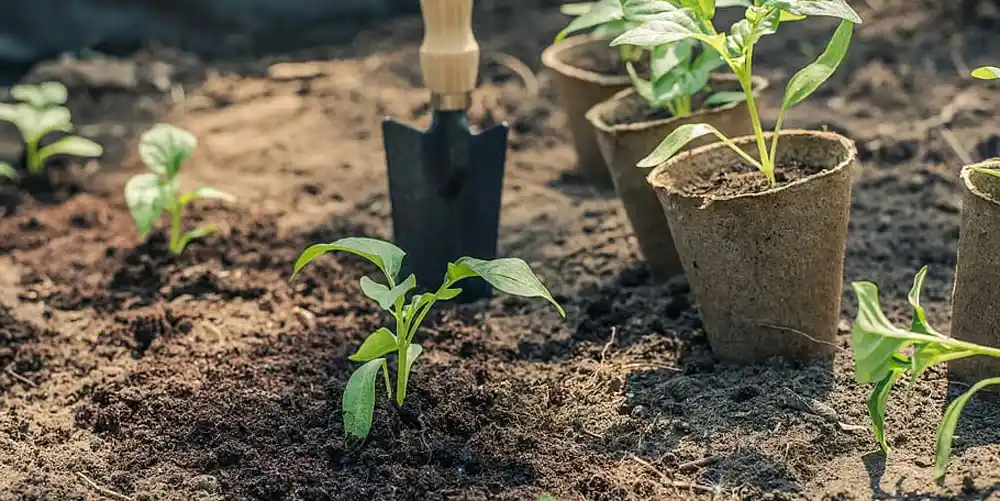Gardening can be a rewarding and enjoyable hobby, but it can also be challenging. Whether you’re a seasoned gardener or just starting out, there’s always something new to learn. These clever tips will help you maximize your garden’s potential, save time and money, and create a thriving outdoor space you can be proud of. From repurposing everyday items to optimizing your watering techniques, get ready to unlock the secrets to a greener, more bountiful garden.
Maximize Your Garden’s Potential
1. Use Coffee Filters in Pots
Prevent soil from escaping through the drainage hole in your pots by placing a coffee filter at the bottom before adding soil. This allows water to drain freely while keeping the soil where it belongs.
2. Eggshells for Calcium
Crush eggshells and add them to your soil to provide a natural source of calcium. Calcium is essential for healthy plant growth, especially for tomatoes and peppers, preventing blossom-end rot.
3. Milk Jug Watering System
Bury a milk jug with holes poked in it near your plants. Fill the jug with water, and it will slowly release moisture directly to the roots, reducing water waste and promoting deep root growth.
Factoid: Did you know that coffee grounds can also be used as a natural fertilizer? They are rich in nitrogen and can help acidify the soil, which is beneficial for plants like blueberries and azaleas.
4. Epsom Salt for Greener Leaves
Mix Epsom salt with water and spray it on your plants to promote greener leaves. Epsom salt contains magnesium sulfate, which helps plants absorb nutrients and improves chlorophyll production.
5. Cinnamon as a Natural Fungicide
Sprinkle cinnamon around seedlings to prevent fungal diseases like damping-off. Cinnamon has natural antifungal properties that can protect young plants from harmful pathogens.
Save Time and Money in the Garden
6. Repurpose Kitchen Scraps
Don’t throw away vegetable scraps! Use them to make vegetable broth for watering your plants. The broth is packed with nutrients that can boost plant growth.
7. DIY Seed Starter Pots
Make your own seed starter pots from toilet paper rolls or egg cartons. These biodegradable pots can be planted directly into the ground, eliminating transplant shock.
8. Vinegar Weed Killer
Use vinegar to kill weeds naturally. Spray undiluted white vinegar directly on weeds, avoiding contact with your desired plants. The acetic acid in vinegar will dehydrate and kill the weeds.
9. Free Fertilizer with Banana Peels
Bury banana peels near your rose bushes or other plants that love potassium. Banana peels decompose and release potassium into the soil, promoting healthy growth and vibrant blooms.
10. Collect Rainwater
Set up rain barrels to collect rainwater for watering your garden. This saves money on your water bill and provides your plants with soft, chemical-free water.
Create a Thriving Outdoor Space
11. Vertical Gardening with Pallets
Repurpose old pallets into vertical gardens. Attach pots or fabric pockets to the pallet to create a unique and space-saving way to grow herbs, flowers, or vegetables.
12. Attract Pollinators
Plant flowers that attract pollinators like bees and butterflies. Include a variety of colors and shapes to provide a constant source of nectar and pollen throughout the growing season. Consider these plants:
- Lavender
- Bee Balm
- Sunflowers
- Zinnias
13. Companion Planting
Use companion planting to improve plant health and deter pests. For example, plant basil near tomatoes to repel tomato hornworms, or plant marigolds near vegetables to deter nematodes.
14. Mulch, Mulch, Mulch!
Mulch your garden beds to retain moisture, suppress weeds, and regulate soil temperature. Use organic mulches like straw, wood chips, or shredded leaves.
15. Create a Compost Pile
Start a compost pile to recycle kitchen scraps and yard waste into nutrient-rich soil amendment. Compost improves soil structure, fertility, and water retention.
16. Use Epsom Salts for Tomatoes
Tomatoes love Epsom Salts. Add one tablespoon per gallon of water and use to water your tomato plants, especially when they are setting fruit. This will boost their magnesium levels.
17. Protect Plants from Frost
Cover delicate plants with blankets or sheets during frost warnings to protect them from damage. Remove the covers in the morning to allow the plants to breathe.
18. Label Your Plants
Use plant markers to label your plants, especially if you’re growing multiple varieties of the same vegetable. This will help you keep track of what you’ve planted and where.
19. Prune Regularly
Prune your plants regularly to encourage new growth and improve air circulation. Remove dead or diseased branches to prevent the spread of disease.
20. Keep a Garden Journal
Keep a garden journal to track your successes and failures. Note what you planted, when you planted it, and how it performed. This will help you make better decisions in future years.
FAQ: Gardening Tips and Tricks
Q: How often should I water my garden?
A: Watering frequency depends on the weather, soil type, and plant needs. Check the soil moisture regularly and water when the top inch feels dry.
Q: What’s the best way to control weeds?
A: Mulching, hand-pulling, and using natural weed killers like vinegar are effective methods for controlling weeds.
Q: How can I improve my soil?
A: Adding compost, manure, or other organic matter to your soil can improve its structure, fertility, and water retention.
Q: What are some common garden pests and how can I control them?
A: Common garden pests include aphids, caterpillars, and slugs. Use natural pest control methods like insecticidal soap, neem oil, or hand-picking.
Q: When is the best time to plant vegetables?
A: The best time to plant vegetables depends on your climate and the specific vegetable. Refer to a planting guide for your region to determine the optimal planting times.

